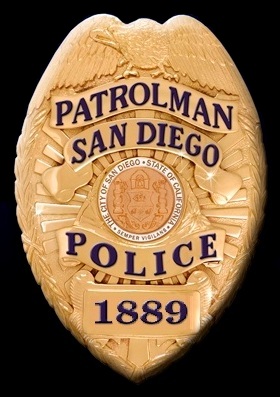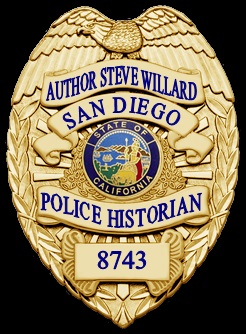

The Radio Room was located in the tower above the Patrol Captain's Office. The SDPD, Sheriff, SDFD and the Police Departments of Coronado, Chula Vista, National City, La Mesa and El Cajon were all on the same frequency.
In 1947 you were issued a .38 caliber revolver, 18 cartridges, a badge, and a cap piece, a short wooden baton, which was carried in the sap pocket of the trousers, a call box key and an I.D. card. You bought the rest, i.e. cap, two uniforms, gun belt, leather jacket, dress uniform jacket, raincoat, boots, flashlight, handcuffs and a First Aid kit. Some first aid items could be obtained from the doctor's office at the jail, but you had to purchase all other items.
In 1947 the only authorized uniform shirts were made of wool and had long sleeves. They cost $12.00 each. Uniform pants were also made of wool and cost $18.00 each. Our gun belts were made of black smooth leather, no embossing. We carried two ammo cases, holster, handcuff case, key ring and four keepers – those cost $35.00. The belts had to be made by one of two leather makers in the downtown area. I believe the names were Mc Phearson's and Mc Kibbin's.
All women arrested for prostitution, or "shacking up", had a HD (health hold) attached to their booking slip and had to spend five days in jail to complete a venereal disease check, conducted by the Police Physician, before being released.
Patrol Captains wore heavy blue wool dress coats and the Sam Brown (shoulder strap) with their gun belt.
In 1947 there was a blue light above the intersection of 5th and Broadway that could be illuminated to notify the beat patrolman to call the Patrol Captain.
Tin 1947 there were security boxes located on the main streets leaving the city, i.e. Harbor Drive and Main Street at the City Limits with National City, 73rd and El Cajon and US 101 in Torrey Pines that contained pylons, barricades, lanterns and signs. After a major crime, i.e. bank robbery, beat cars were dispatched and they used the equipment to blockade the street so that all vehicles were made to stop and be inspected for suspects.
There was no such thing as "overtime" in 1947. Tough luck if you couldn't get your reports typed during your shift.
Flashlight batteries were furnished and were kept in a closet in the Patrol Captain's Office. To get new ones, you had to turn in the same number of used batteries.
In 1947 sirens were located on the left front fender of the patrol car.
In 1947 there were three sub-stations. They were located in La Jolla, Ocean Beach and East San Diego. The La Jolla sub-station was located in the Fire Station at Herschel and Wall. The Ocean Beach sub-station shared quarters with the Life Guard Station and East San Diego sub-station was adjacent to the fire station. The La Jolla car (Unit 28) worked from the La Jolla sub-station. The Ocean Beach car (Unit 26), which patrolled Ocean Beach and all of Point Loma and Unit 27, which covered Mission Beach and Pacific Beach, worked from the Ocean Beach sub-station. Unit 22, which covered from Park Blvd. to 32nd St. and Unit 23, which covered from 32nd Street to 73rd Street, worked from the East San Diego sub-station. The three sub-stations were under the command of a Patrol Captain, who had his office in the La Jolla sub-station. When on duty, he made trips to each sub-station to check their operations.
The East San Diego and La Jolla sub-stations each had an ambulance unit. When they were notified by Central that an ambulance was needed, the desk man locked the door and manned the ambulance. Central had two ambulances which were manned by a jailor, who had been designed as the driver. Within the flash of an eye, they slipped on the white coats and they were officially ambulance drivers.
In 1947 the only uniformed women were Jail Matrons. Their primary duties included searching all female prisoners entering the jail, fingerprinting the prisoners, supervising the female tank assisting the Police Physician while he was examining female prisoners.
In 1947 there were only three black members of the Police Department. Sgt. Bert Ritchie in Investigations, Jack Bransford was assigned to the radio room and Jasper Davis, who did foot patrol on Imperial Ave. between 25th and 30th Streets during the evening and early night hours.
In 1947 an Officer in uniform rode free on any streetcar or bus.
In the 1950’s the city tried to save money by purchasing Plymouths and Ford 6's as Patrol Cars. Both cars lacked power and speed and almost every other car on the road could outrun them. US 395 had just been constructed through Balboa Park, but not open to traffic, when my partner and I bypassed the barricades and gave our Ford 6 a speed test. We couldn't get it over 90 mph.
When transients were arrested for vagrancy they appeared in court where Judge John J. Brennan gave them a suspended sentence on the condition that they leave town by 1:00 PM that day.
When I began my career the highest rank below Chief was Captain.
When the Kettner Street entrance to the Old HQ garage was closed and locked at midnight - all police cars entered the patio and garage through the front arched entrance.
In the mid 1950's, the Narcotic Detail was a part of the Vice Squad. Vice Squad Officers assisted the Narcotic Detail officers conduct surveillances. All narcotic evidence was kept in a steel container 10x13x18 and was secured with a padlock. The Vice Squad was adjacent to the Chief's Office and the steel container was stored in a safe in the Chief's Office. The Vice Squad was commanded by a Sergeant, who answered only to the Chief.

Retired SDPD Lieutenant John Hoolihan put together a look back at a simpler time in police work.
LET'S GO BACK A LITTLE FARTHER – MEMORIES BEGINNING IN 1947.
Do you remember "Lieutenant Bob Karrow's College of Knowledge?" That was the start of the police academy. In 1947, recruits attended on week days from 1:00 PM to 5:00 PM, had one hour off for a bite to eat and then worked the 4th Watch from 6:00 PM to 2:00 PM. Back then all police officers worked a 44 hour week, with one day off one week and then two days off the following week.
Remember the two bowling alleys below the old HQ gym with a small cubicle manned by Glenn “Kewpie” Treleven, a retired Lieutenant? Kewpie also sold bowling at five cents per line and candy, cigarettes, soda, coffee, etc. Sometime in the 1950's, the bowling alleys and cubicle were removed and replaced with a coffee shop and an extra locker room.
In 1947 only the east parking lot in front of the old HQ was used for parking. What is now the west lot was landscaped until it was paved for more parking. Yes, all of the police cars were parked, refueled and repaired inside the garage.


The CRIME FILES
